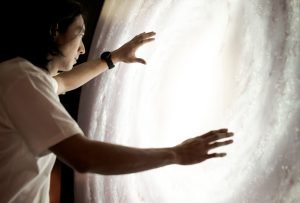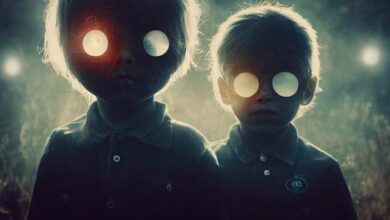The Fundamental Fabric of Reality

 Have you ever had a dream so vivid that you thought it was real, only to wake up and realize it was all in your mind? What if our waking reality is similar—not a fixed, physical stage, but a construct of consciousness?
Have you ever had a dream so vivid that you thought it was real, only to wake up and realize it was all in your mind? What if our waking reality is similar—not a fixed, physical stage, but a construct of consciousness?
Science has leaned on a materialistic view, asserting that the physical world is primary and consciousness is merely a byproduct of brain activity.
Yet, emerging evidence from physics, consciousness studies, and ancient wisdom suggests that consciousness is fundamental, creating our perceptions of the physical world, including the laws of General Relativity and Quantum Mechanics.
Beyond Space and Time
Modern physics rests on two monumental theories: Quantum Mechanics, which governs the behavior of particles at the smallest scales, and General Relativity, which describes gravity and the structure of space-time at the largest scales.
Quantum Mechanics reveals a strange world where particles can exist in multiple states at once—like a coin spinning in the air, neither heads nor tails until it lands.
General Relativity, Einstein’s brainchild, portrays gravity as the curvature of space-time caused by mass and energy. Picture a heavy ball on a trampoline, creating a dip that guides the path of smaller balls rolling nearby.
These theories excel in their domains, but they clash when we zoom in to the tiniest scales imaginable: the Planck Length (10⁻³⁵ meters) and Planck Time (10⁻⁴³ seconds). At these limits, our understanding of physics unravels.
It’s as if we’re trying to measure an ant with a ruler marked only in meters—our tools simply aren’t precise enough. This breakdown hints that space and time, the very fabric of reality we take for granted, may not be fundamental.
This suspicion gained weight with the 2022 Nobel Prize-winning discovery in quantum physics, which confirmed that the universe is not “locally real.” In simple terms, particles don’t have definite properties—like position or speed—until they’re observed. This challenges the classical idea of an objective, independent reality, suggesting that observation (and thus consciousness) plays a role in shaping what we perceive.
Enter the amplituhedron, a geometric marvel discovered in 2013. This object exists outside space and time, offering a new way to compute particle interactions in quantum field theory. Imagine a complex puzzle that usually takes hours to solve. Now picture a shortcut that lets you crack it in minutes without even knowing the rules.
The amplituhedron is that shortcut, encoding forces and interactions purely within its geometry, bypassing space and time entirely. Its implications are profound: space and time might be emergent properties, like shadows cast by a deeper, more fundamental reality.

The Mind Beyond the Brain
If space and time aren’t the bedrock of existence, what is? A growing chorus of researchers points to consciousness. Professor Donald Hoffman, a cognitive scientist, proposes a mathematically grounded theory that consciousness is fundamental. He likens reality to a user interface—think of a computer desktop.
The icons you click don’t reveal the intricate code beneath; they’re simplified representations. Similarly, our perceptions of the physical world might be a simplified projection of a consciousness-based reality.
Evidence for this extends beyond theory into empirical studies. Psi phenomena—abilities like telepathy, precognition, and psychokinesis—suggest consciousness isn’t confined to the brain. Dean Radin, a leading researcher, has compiled 157 peer-reviewed studies showing measurable effects.
In one experiment, people influenced random number generators with their thoughts, as if their minds could nudge the physical world. In another, participants accurately sensed events before they occurred, hinting that consciousness transcends time.
At the University of Virginia, researchers like Jim Tucker have documented children recalling detailed past-life memories, often verified by historical records. A child might describe a village they’ve never visited, naming people and events later confirmed to be real. These cases challenge the idea that consciousness begins and ends with the brain.
Remote viewing, explored in CIA experiments and follow-up studies, further blurs spatial boundaries. Participants described distant locations—sometimes thousands of miles away—with uncanny accuracy, as if their awareness could travel beyond their bodies.
Robert Monroe’s Gateway Experience takes this a step further. Using techniques like Hemi-Sync (synchronized sound waves), Monroe developed a method to induce out-of-body states. At the Monroe Institute, people report encountering non-physical realms and intelligent entities, suggesting that reality is a construct of consciousness, accessible through practice.
Perhaps the most striking evidence comes from near-death experiences (NDEs). Cardiologist Pim van Lommel has studied cases where individuals, clinically dead with minimal brain activity, report vivid awareness—seeing their bodies from above or meeting deceased loved ones.

Beyond Science
Science offers measurable clues, but other experiences reinforce the primacy of consciousness. Channeled material, like the Law of One or Dolores Cannon’s works, claims to tap into universal truths, asserting that consciousness underpins reality.
Thousands of UAP (Unidentified Aerial Phenomena) abduction accounts echo this theme. People report not just physical encounters but profound shifts in perception—feelings of interconnectedness or the dissolution of material boundaries.
Authors like Chris Bledsoe (UFO of God) and Whitley Strieber (Them) recount their own anomalous experiences. Bledsoe describes a life-altering encounter that sparked a spiritual awakening, while Strieber notes how UAP interactions often reveal reality as a fluid, consciousness-driven phenomenon. These accounts suggest that to grasp such mysteries, we must move beyond materialism and embrace a broader view of existence.
This isn’t a new idea. Ancient traditions have long held that consciousness is the foundation of reality. Rosicrucianism, Gnosticism, Kabbalah, Theosophy, and The Kybalion teach that the material world is an illusion, a veil over a deeper truth.
In the Vedic texts, like the Upanishads, Brahman—pure consciousness—is the ultimate reality from which all else arises. These philosophies see the physical as a shadow cast by the mind, not the other way around.
Modern science is beginning to align with this wisdom. Max Planck, the father of Quantum Mechanics, famously declared: “I regard consciousness as fundamental. I regard matter as derivative from consciousness. We cannot get behind consciousness. Everything that we talk about, everything that we regard as existing, postulates consciousness.”
Even Albert Einstein mused, “Reality is merely an illusion, albeit a very persistent one,” while Erwin Schrödinger pondered consciousness’s role in quantum events.
Consider the analogy of a video game. Characters within the game experience a world with its own physics—gravity, light, time—but the true reality is the code and the computer running it. Our physical world, with its General Relativity and Quantum Mechanics, might be like that game, with consciousness as the underlying code.
From the Planck scale’s mysteries to the amplituhedron’s revelations, from psi phenomena and NDEs to ancient teachings and UAP encounters, the evidence converges on a radical idea: consciousness is fundamental. General Relativity and Quantum Mechanics, once thought to describe an objective reality, may instead be emergent frameworks within a consciousness-driven cosmos.
If consciousness precedes matter, we might unlock not only scientific breakthroughs but a profound sense of unity and purpose—a reality where the mind isn’t a guest in the universe, but its very architect.




